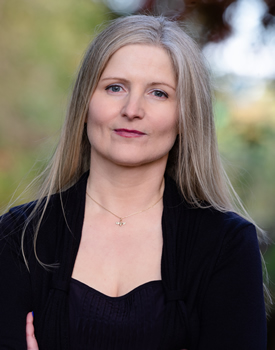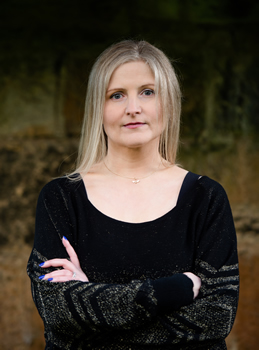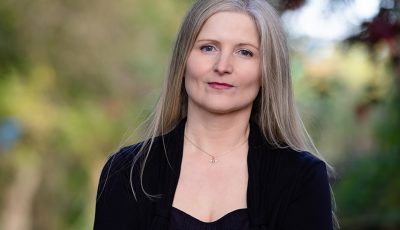

Up Close: Carole Johnstone
False Memories
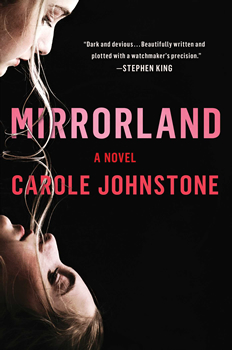 By Dawn Ius
By Dawn Ius
Carole Johnstone remembers vividly the stark and cold pantry in her grandparents’ house where she and her cousins used to find refuge during countless games of hide-and-seek and sardines. Along the wall at the pantry’s end was a cupboard big enough to climb into, and it became one of Johnstone’s favorite places.
For years, she also recalled the full-sized locked door in the back of that cupboard.
“I was both fascinated and scared by it,” she says. “I wondered if it would ever be unlocked, and if so, what would be on the other side.”
But it wasn’t until she was in her 30s when a discussion with her mum revealed a shocking truth: there had never been a door in the back of that cupboard. The memory was completely false.
“To say that I was freaked out is an understatement,” Johnstone says. “If I close my eyes now, I can still see that door, clear as day.”
And this was the spark for her staggeringly beautiful debut, MIRRORLAND, a gothic story of suspense about twin sisters, dark childhood secrets, and the power of imagination.
The book takes place at 36 Westeryk Place in Edinburgh where Cat and her estranged sister, El, grew up. As children, the twins invented “Mirrorland,” an imaginary place under the pantry stairs full of pirates, witches, and clowns. Cat has long ago left that place behind, exchanging fantasy for a life in California. But when her sister goes missing after going out on her sailboat, Cat is forced to return to help find her.
Johnstone pulls out all the stops in creating an atmospheric mystery that leads Cat through the dark corners of her childhood home to confront the terrifying ghosts of her past—ghosts that are leading her right back to Mirrorland, where her memories as an adult differ vastly from what she remembers as a child.
“I became obsessed with how memories, particularly childhood memories, are made and all the ways in which they can be completely false,” Johnstone says. “How fantasy is routinely used by children to try to explain a world that they can’t yet understand. And how those interpretations might affect the life of the adult they become.”
In this exclusive interview with The Big Thrill, Johnstone shares more about how bits of her childhood wove themselves into her genre-bending debut.
This is such an atmospheric story—we’re transported to every individual location thanks to your evocative description. What are some of the ways you’ve learned to create such spellbinding atmosphere?
Thank you so much! I love to read stories that effortlessly draw you into their world, no matter where or what that world is. I think it’s so important as a writer to create places that a reader can very quickly see and touch and smell and feel and understand.
36 Westeryk Road, the big creepy old house in Edinburgh that Cat and El grew up in, is based on my memories of my grandparents’ 200-year-old Georgian house in Leith, the northern port district of Edinburgh. My sister and I spent almost every holiday there growing up in the ’80s and ’90s, and it was a hugely eccentric house, full of strange rooms and secret hidey holes. Originally, I was planning on setting MIRRORLAND in a grand old mansion in the middle of nowhere, but from the very beginning whenever I thought about the story, my grandparents’ house was the only house I saw. Which has undoubtedly helped in terms of creating an authentic sense of atmosphere!
Another method I’ve always used when I’m trying to describe a fictional place and its characteristics, its vibe, is to imagine I’m watching it in a movie. What does it looks like, what aspects of it work and stand out and which don’t, how best could it be filmed: from what angles and through what kind of lens? It gives me perspective and distance, I suppose; I’m literally designing my own set. And it also allows me to think more like a reader or an impartial observer.
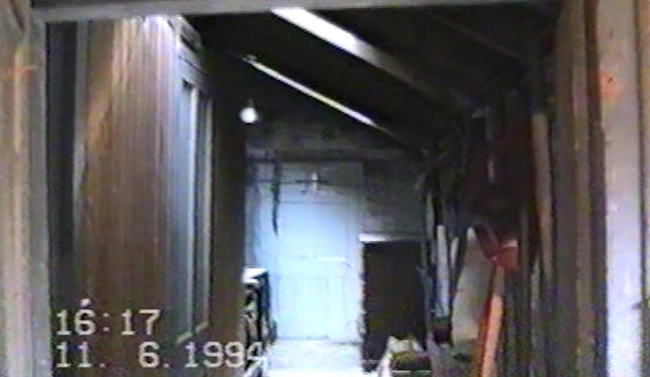
The real (and much smaller) interior of part of the wooden-roofed alleyway that Cat and El’s “Mirrorland” was based upon. The left wall is the southern exterior wall of the house itself. The white door leads to the washhouse.
It’s difficult to categorize MIRRORLAND—it’s one of the best genre mash-ups I’ve read in a long time. What about each of these genres inspires you?
MIRRORLAND is very much a gothic suspense first and foremost, and was inspired by all the classic gothic stories that I loved as a teenager. Jane Eyre, Wuthering Heights, Rebecca, Beloved, Jamaica Inn, The Turn of the Screw, The Haunting of Hill House, to name just a few. Good gothic stories are full of atmosphere and passion—love triangles, revenge plots, murder—and always at their heart, a mystery that needs to be solved, or a secret that needs to be exposed. They can be as much about love as hate, as uplifting as they are thrilling or scary, as contemporary as they are classic. And that’s very much what I wanted MIRRORLAND to be—I wanted to use some elements of the classic gothic story, but I also wanted to set it firmly in the present day.
I love whodunnits. I’ve been a huge Agatha Christie fan all of my life. I enjoy crime fiction that’s full of clues and twists and misdirection. The most satisfying thing for me as a writer is if I manage to completely change a reader’s mind about an event or a person, so that what they believed at the beginning of a book is entirely changed by the time they reach its end.
The fantasy element of the book—the weird and wonderful world of MIRRORLAND that Cat and El create underneath the house—is very much a vehicle for their childhood story. I much prefer my fantasy to be grounded in reality. Children have fiendish imaginations, and for them the boundary between what is real and what is fantasy is so fluid. They easily believe in worlds that live over rainbows, down rabbit holes, and inside wardrobes. I’ve never forgotten what that feels like, and I’ve never stopped being fascinated by what really is a form of magic. Because that imagination—that fantasy, that credulity—has the power to protect a child, even to save her life. Or shape what it will become.
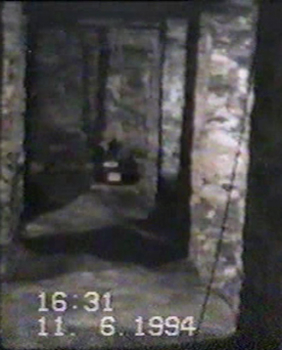
“This was the creepy vaulted cellar we were never allowed into when we were kids,” Johnstone says. “Cat and El’s ‘Mirrorland’ is really an amalgam of the real roofed alleyway running along the south side of house and this cellar.”
Though there are many fantastical elements in your book—pirates, witches, clowns, princesses—you’ve woven in grounded themes such as redemption and revenge. What would you like readers to take away from this story?
I only ever have one aim, and that’s to entertain anyone who reads what I’ve written. To entertain a reader, you need to start with an idea that grabs their imagination; you need to give them characters that they feel they know and scenarios that they can become fully invested in. Most of all, you need to keep their attention. I adore love triangles in fiction because they offer us the chance to become invested in something that isn’t real; we can be judge and jury, we can be outraged on someone’s behalf. Almost always there’s a winner and a loser, so it satisfies in a way that real life often doesn’t. The same goes for revenge plots; the good ones, like The Count of Monte Cristo, are as moving as they are rewarding.
As a writer, I think that you have to at least attempt to give a reader a feeling of joy or hope that they can take into their own lives. That doesn’t necessarily always require a happy ending, but a book has to mean something. And it should always make people feel something. Otherwise, what was the point in writing it?
MIRRORLAND is a dark book. As authors, it’s important that we sometimes immerse ourselves in that world to give the reader the most authentic experience. What are some of the ways you prepare to enter that darkness, but perhaps, more importantly, how are you able to snap back out of it?
I’m not the kind of person that can write during my commute (when I had one!) or my lunch break. I need to be able to sit down at my computer, completely uninterrupted, for hours at a time. Usually, it takes a few of those hours to get properly going, to feel properly immersed. I might read something with a similar vibe for a bit. I’ll put on a movie soundtrack that fits with what I want to write for that day. Even then, it’s still a while before I’m “there,” but once I am, it really is (unless I’m having a bad day), like being there. But only ever as an observer. I’m always one step removed. That way, if I’m writing something that’s very dark or disturbing or sad, I’m able to be quite scientific about it. Mostly! Writing in first person can sometimes blur the boundaries, especially if I’m writing about something close to my own experience.
There’s nearly always a moment at the end of the day where I struggle to come back to my actual life, particularly if I’ve been writing about something that’s very dark or emotional. I kind of take some time for myself before I talk to anyone or do anything—I meditate, or exercise, or perhaps have a drink—and then generally, it’s like closing a door and thinking I don’t have to look in there again until tomorrow.
Although I am not a twin and haven’t had twins, a dear friend has twin daughters, and it’s clear that their bond is more special than even those of very close siblings. They tend to fight bigger, love bigger, and scheme bigger. How did you capture the relationship between El and Cat, which feels so authentically twin?
I think twins, particularly identical twins, are so interesting to write about because, you’re right, they have such a unique perspective. Their bonds are generally much stronger; you have to wonder what it would take to break them. Mirror twins, in particular, are very intriguing: although a lot remains unknown, it’s believed that mirror twins—who have identical but symmetrically opposed physical features and sometimes behaviors—are born when an egg splits much later in the fertilization process: between seven to 10 days after conception. Any longer, and they would have become conjoined. It’s also been suggested that mirror twins are more likely to experience extrasensory perception: feeling the same physical or mental pain as their twin. So they’re a fascinating subject to write about.
From a personal point of view, my mum is actually an identical twin, and my husband is a fraternal twin, so I have a little insider knowledge. Some of Cat and El’s experiences are directly drawn from stories that Mum has told me over the years, as well as from my own observations. Once, when I was a teenager, I asked her why she so rarely corrected people when they said hello to her in the street, wrongly assuming that she was her sister, and she said that it was because she hated that moment when she had to interrupt and tell them that she wasn’t the person they thought she was. How horrible it was to have the friendly familiarity in someone’s eyes suddenly vanish, to be replaced by embarrassment or politeness or even anger.
I’m also a big sister, and can still remember very well the contradictory feelings of innate closeness vs. extreme rivalry; all the ways in which my relationship with my sister has fluctuated and evolved throughout our lives.
Throughout the book, secret after secret is unraveled, and you’ve woven in so many great twists. Are you a plotter or pantser? What advice would you give to writers on creating those plot turns?
I am a meticulous plotter! Partly because that’s just the way I write, and mostly because if a story is quite complex, with a lot of reveals and clues and misdirection, it needs to appear as simple as possible! And the easiest way to achieve that is to plot and plot. With MIRRORLAND, it wasn’t just a case of having to know the end before I started, I needed to plot it all out in detail chapter by chapter over and over again. It’s not unusual for the planning stage to take almost as long as the writing of the first draft for me, but it always saves so much time in the long run.
As to advice on how to write plot turns, I think the best advice I ever received was “show don’t tell.” Have lots of little clues, lots of smaller pre-emptive turns; most of which are almost unnoticeable, almost subconsciously planted in a reader’s head. It’s so important if you’re going to write a story with twists and turns, that every single one of them makes sense. That every single character stays in character. That everything that happens is rooted in reality. There’s little point in having twists at all if a reader isn’t going to believe them—in other words, if you haven’t put in the groundwork first. I’m not a huge fan of stories that only have a huge audacious twist as their climax, because almost everything that comes before it has to drive the plot towards that reveal, which can sometimes make for a very weird or dull book up until the end. For me, numerous smaller twists and surprises revealed throughout a story is far more satisfying.
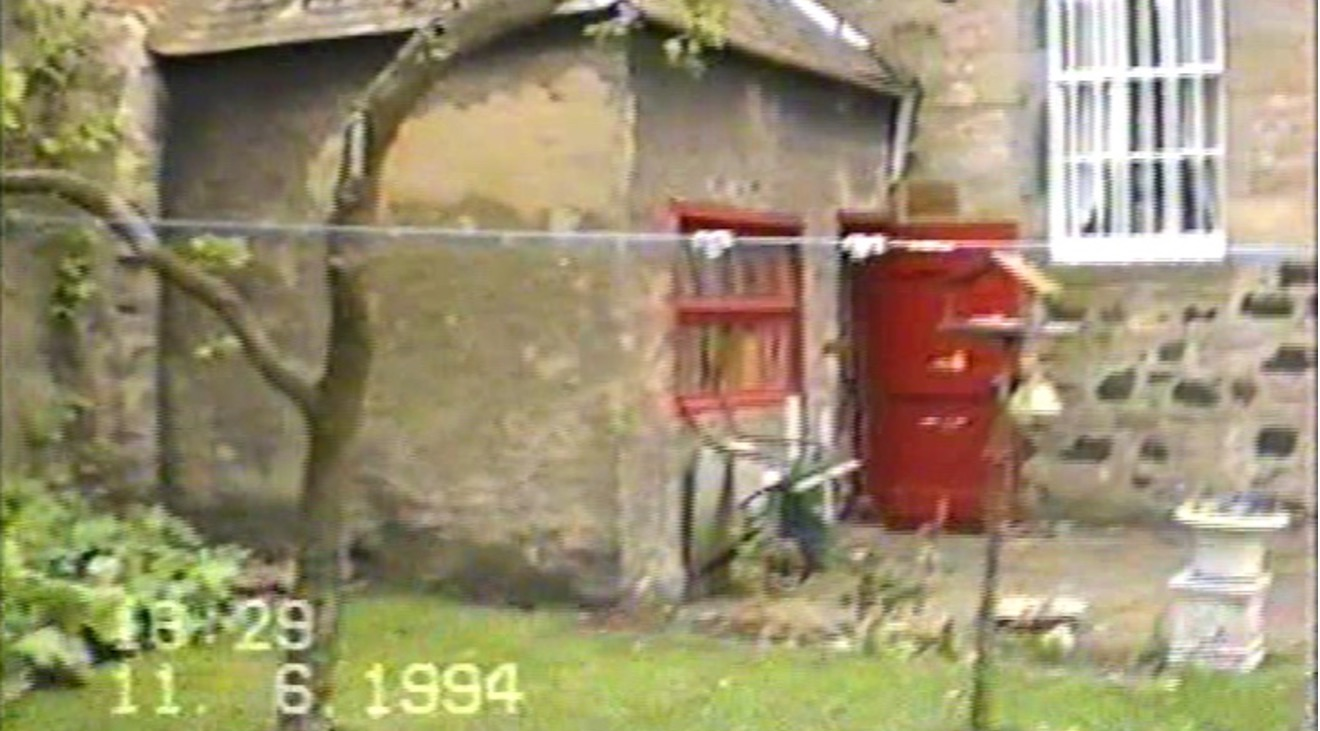
A video still of the stone washhouse, taken from the back garden. The white window is the “Pantry” in the novel, leading to the entrance to “Mirrorland” (the roofed alleyway that runs along the south side of the main house).
Due to the magical realism and fantasy elements of MIRRORLAND, world-building was important. What methods did you employ to create such rich and robust environments?
I spent a lot of time drawing floor plans of my grandparents’ house as best as I could remember it. I watched old home videos both of the house and of my sister and me growing up. I did a lot of daydreaming and sketched out MIRRORLAND itself in my mind; how Cat and El might have created it, the logistics and reality versus the fantasy; how its whole world would evolve as they got older and their lives began to dramatically change. It was so important to ground MIRRORLAND in the real world. I probably spent as long imagining all of these things as I did the initial plotting.
What can you share about what you are working on next?
I’ve already written my second book and am editing it as we speak—although I can’t say too much about it yet. It’s a very unusual murder mystery set in the Outer Hebrides, and all being well it should be published in the UK by Borough Press/HarperCollins around the spring of 2022. I’m very much hoping that it will find a home in the US and Canada too!
- On the Cover: Alisa Lynn Valdés - March 31, 2023
- On the Cover: Melissa Cassera - March 31, 2023
- Behind the Scenes: From Book to Netflix - March 31, 2023

